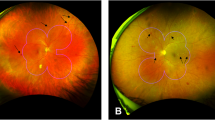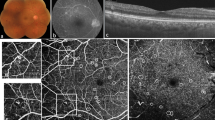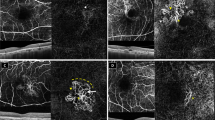Abstract
Purpose
To investigate the distribution pattern of microaneurysms (MAs) and capillary dropouts (CDOs) related to retinal thickness in patients with diabetic macular edema (DME).
Methods
We designed a cross-sectional observational study in which we manually merged fluorescein angiography and optical coherence tomography (OCT) map and located MAs and CDOs areas. The density of MAs, the width and the length of circumference of CDOs, and the number of MAs adjacent to CDOs were compared between highly thickened (white area (WA) in OCT map) and border areas (red area (RA)).
Results
We examined 115 eyes of 115 patients with DME. The density of MAs in RA (1.086 ± 0.616) was significantly higher than that in WA (0.8601 ± 1.086) (p = 0.002). The MA rates adjacent to CDOs in WA and RA were 79.1% and 80.7%, respectively. In the RA, the size of CDO adjacent to MAs was smaller (p = 0.013), but its circumference was longer (p = 0.018), and the number of MAs adjacent to CDOs was larger than those in WA (p = 0.002). The total length of circumference of CDOs was significantly correlated with the number of MAs adjacent to CDOs in WA (p = 0.011, R2 = 0.68) and RA (p = 0.008, R2 = 0.81).
Conclusion
Smaller but more CDOs with longer circumference adjacent to MAs contribute to the higher density of MAs in the surrounding areas of DME.




Similar content being viewed by others
Data availability
The datasets generated during and/or analyzed during the current study are available from the corresponding author on reasonable request.
References
Moss SE, Klein R, Klein BE (1998) The 14-year incidence of visual loss in a diabetic population. Ophthalmology 105:998–1003. https://doi.org/10.1016/S0161-6420(98)96025-0
Aiello LP, Avery RL, Arrigg PG et al (1994) Vascular endothelial growth factor in ocular fluid of patients with diabetic retinopathy and other retinal disorders. N Engl J Med 331:1480–1487. https://doi.org/10.1056/NEJM199412013312203
Terasaki H, Ogura Y, Kitano S et al (2018) Management of diabetic macular edema in Japan: a review and expert opinion. Jpn J Ophthalmol 62:1–23. https://doi.org/10.1007/s10384-017-0537-6
Antcliff RJ, Marshall J (1999) The pathogenesis of edema in diabetic maculopathy. Semin Ophthalmol 14:223–232. https://doi.org/10.0153/SOPH01400197
Xue K, Yang E, Chong NV (2017) Classification of diabetic macular oedema using ultra-widefield angiography and implications for response to anti-VEGF therapy. Br J Ophthalmol 101:559–563. https://doi.org/10.1136/bjophthalmol-2016-308704
Patel RD, Messner LV, Teitelbaum B et al (2013) Characterization of ischemic index using ultra-widefield fluorescein angiography in patients with focal and diffuse recalcitrant diabetic macular edema. Am J Ophthalmol 155:1038–1044.e2. https://doi.org/10.1016/j.ajo.2013.01.007
Ogura Y, Shiraga F, Terasaki H et al (2017) Clinical practice pattern in management of diabetic macular edema in Japan: survey results of Japanese retinal specialists. Jpn J Ophthalmol 61:43–50. https://doi.org/10.1007/s10384-016-0481-x
Wells JA, Glassman AR, Ayala AR et al (2015) Aflibercept, bevacizumab, or ranibizumab for diabetic macular edema. N Engl J Med 372:1193–1203. https://doi.org/10.1056/NEJMoa1414264
Elman MJ, Bressler NM, Qin H et al (2011) Expanded 2-year follow-up of ranibizumab plus prompt or deferred laser or triamcinolone plus prompt laser for diabetic macular edema. Ophthalmology 118:609–614. https://doi.org/10.1016/j.ophtha.2010.12.033
Hirano T, Toriyama Y, Iesato Y et al (2017) Effect of leaking perifoveal microaneurysms on resolution of diabetic macular edema treated by combination therapy using anti-vascular endothelial growth factor and short pulse focal/grid laser photocoagulation. Jpn J Ophthalmol 61:51–60. https://doi.org/10.1007/s10384-016-0483-8
Stefánsson E, Chan YK, Bek T et al (2018) Laws of physics help explain capillary non-perfusion in diabetic retinopathy. Eye 32:210–212. https://doi.org/10.1038/eye.2017.313
Hee MR, Puliafito CA, Duker JS et al (1998) Topography of diabetic macular edema with optical coherence tomography. Ophthalmology 105:360–370
Takamura Y, Matsumura T, Arimura S et al (2018) Direct photocoagulation guided by merged retinal images for the treatment of focal diabetic macular edema. Int J Endocrinol 2018:1–7. https://doi.org/10.1155/2018/2401094
Allingham MJ, Mukherjee D, Lally EB et al (2017) A quantitative approach to predict differential effects of anti-VEGF treatment on diffuse and focal leakage in patients with diabetic macular edema: a pilot study. Transl Vis Sci Technol 6:7. https://doi.org/10.1167/tvst.6.2.7
Leicht SF, Kernt M, Neubauer A et al (2014) Microaneurysm turnover in diabetic retinopathy assessed by automated RetmarkerDR image analysis - potential role as biomarker of response to ranibizumab treatment. Ophthalmologica 231:198–203. https://doi.org/10.1159/000357505
Tolentino MJ, Miller JW, Gragoudas ES et al (1996) Intravitreous injections of vascular endothelial growth factor produce retinal ischemia and microangiopathy in an adult primate. Ophthalmology 103:1820–1828
Funding
Publication of this article was supported in part by grants-in-aid for scientific research (J160000936) from the Japan Society for the Promotion of Science, Tokyo, Japan.
Author information
Authors and Affiliations
Contributions
Y. Takamura contributed with conception or design of the work, data collection, data analysis, drafting the article, and critical revision of the article. K. Noda, M. Morioka, Y. Hashimoto, and M. Gozawa participated in data collection and analysis. Y. Yamada participated in data analysis. M. Inatani contributed with conception and design of the work.
Corresponding author
Ethics declarations
Conflict of interest
All authors declare that they have no conflict of interest.
Ethical approval
All procedures performed in studies involving human participants were in accordance with the ethical standards of the institutional and/or national research committee and with the 1964 Helsinki declaration and its later amendments or comparable ethical standards.
Consent to participate
Informed consent was obtained from all individual participants included in the study.
Additional information
Publisher’s note
Springer Nature remains neutral with regard to jurisdictional claims in published maps and institutional affiliations.
Rights and permissions
About this article
Cite this article
Takamura, Y., Yamada, Y., Noda, K. et al. Characteristic distribution of microaneurysms and capillary dropouts in diabetic macular edema. Graefes Arch Clin Exp Ophthalmol 258, 1625–1630 (2020). https://doi.org/10.1007/s00417-020-04722-8
Received:
Revised:
Accepted:
Published:
Issue Date:
DOI: https://doi.org/10.1007/s00417-020-04722-8




